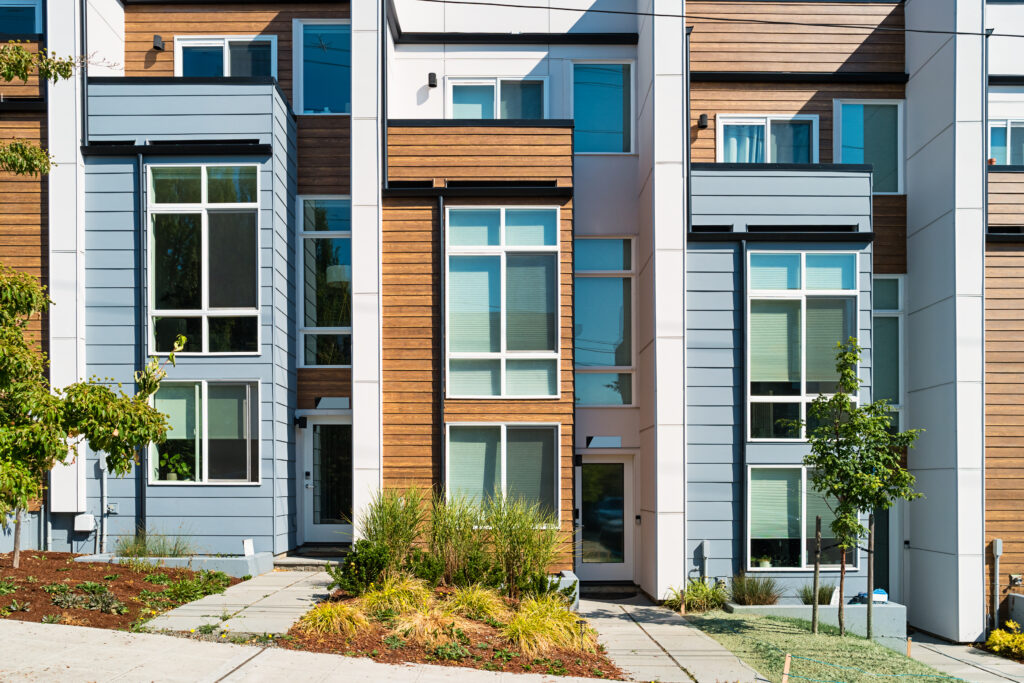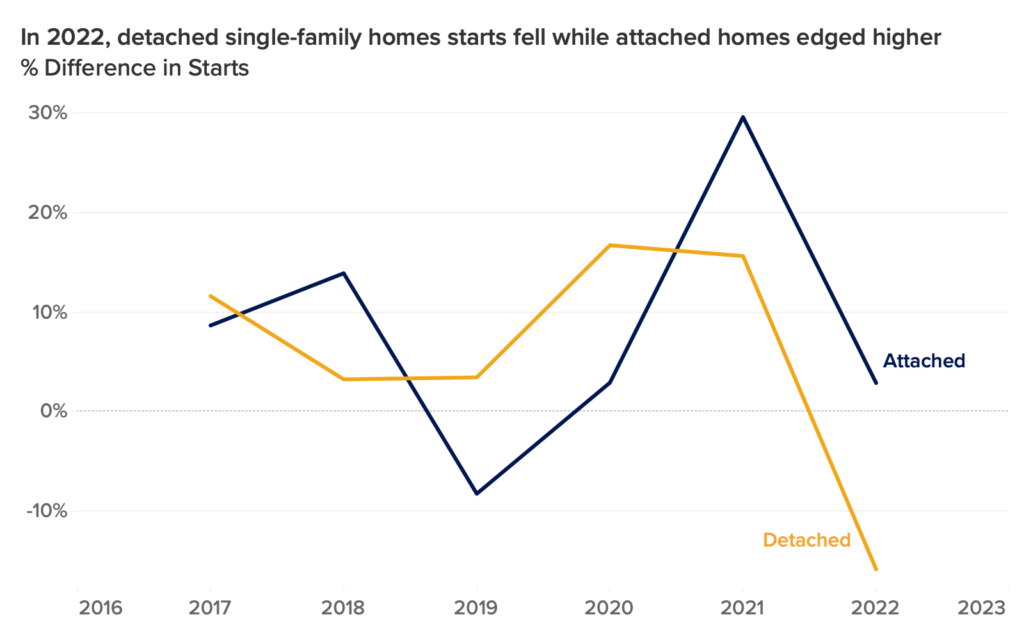Higher Costs Pushed Builders Toward Smaller, Attached Homes


Single-family home construction rose during the pandemic, as builders, incentivized by strong housing demand and rising prices, upped activity to address the nation’s housing gap. But attempts to fight persistent inflation in 2022 led interest rates to rise, financing costs to increase and home buying demand to cool. Not only did construction slow as a result, but the types of homes being built – and how they’re built – changed, as well. An analysis of the Survey of Construction 2022 microdata shows that builders quickly began building smaller, attached homes – with more stories and fewer bedrooms — than they had in previous years. They also started a larger share of homes off-site than they had in the past.
Even as COVID-19 brought the world to halt and stunted supply chains, homebuilders powered through in the pandemic’s early days, putting up new single-family homes at the fastest rate since before the Global Financial Crisis. Builders began construction on nearly 994,000 single-family homes in 2020, up 11.5% from a year before. That pace increased again in 2021 with more than 1.1 million more single family homes beginning construction – another double-digit percent annual increase. What’s more, nearly 970,000 single-family homes completed construction that year – the largest calendar-year addition to the housing stock since 2007, at the time.
While home completions of new single-family homes continued to grow in 2022, the succession of economic shocks from the past few years – supply chain issues early in the pandemic as well as rising builder costs and falling affordability later on – caused builders to change course. Starts of single-family home construction projects fell 10.1% in 2022 from 2021 – the first annual calendar year decline since 2011 – and the types of homes that builders put up also saw a notable change. Specifically, the homes that builders opted to begin work on became smaller, more likely to be attached and more likely to be built offsite.
New construction projects of standalone (or “detached”) homes declined by 12% in 2022 from 2021, while starts of “attached” single-family homes, like condos and townhouses, continued to increase, rising 2.9% over that same span.

Another way to view this change is to compare activity to pre-pandemic levels. Single-family home starts in 2022 exceeded 2019’s starts by 14.3%. While detached homes make up the large majority (on average, more than 85%) of new single-family home construction, this growth from pre-pandemic levels was more concentrated in attached homes. More than 37% more attached single-family homes began construction in 2022 compared to 2019, and detached single-family construction starts increased by just 11% during the same period.
The increase in new single-family home construction in 2022 was also concentrated among smaller housing units with fewer bedrooms. Starts of single-family homes with fewer than three bedrooms increased by 9.5% in 2022 from 2021 while construction on homes with three bedrooms or more fell by 13.1% over that same span. This shift is likely due in part to builders responding to worsening affordability for potential first time home buyers.
What’s more, new homes got taller but smaller. Single-family homes more than two stories tall saw construction starts increase by 4.9% while starts of single-family homes with two stories or fewer fell by 10.8%. These new homes also shrunk relative to lot size in 2022, reversing a trend that had formed over four years. Controlling for lot area, square footage of newly-constructed single-family homes increased from 2018 through 2021. As costs increased and housing demand fell in 2022, the size of the median new single-family home fell by 100 square feet (-4.3%), while the median lot size stayed flat. As a result, the ratio of the two measures decreased.
Lastly, 2022 saw an increase in single-family homes being constructed off-site. Starts of such projects – which tend to be modular, panelized or precut homes – saw a 23.9% annual increase in 2022 from 2021. That’s compared to more traditional on-site single-family home construction projects which saw a 11.2% decline over that same period. Compared to pre-pandemic 2019 levels, off-site starts of single-family home building projects were up 18.8% in 2022, while on-site projects were up 14.0%. The uptick in off-site activity was likely in response to challenges that tight, unpredictable supply chains and rising costs posed to builders. Constructing homes off-site tends to allow for more efficiency and consistency, albeit sometimes at the expense of a home’s specificity or custom features. Modular homes are also less expensive than site-built homes.
Affordability challenges brought upon by rising interest rates and persistent home price growth resulted in increased competition for smaller, more affordable homes in 2022. Builders – also faced with higher financing costs – responded to this shift in demand by building smaller. Considering the typical family size is falling and that many older Americans will likely be looking to downsize, the shift to smaller homes is likely to persist.
While the decline in single-family housing starts in 2022 does not bode well for housing affordability, builders’ ability to pivot quickly amid the higher interest rate environment by shifting how and what they build is good news for home buyers.
Unfortunately, builders still face many challenges. A more rigid regulatory climate could slow down necessary adjustments in residential construction. Land use regulatory practices affect housing supply and affordability. Many localities still prohibit the construction of any housing structure other than single-family detached homes.
Housing experts and economists agree: Allowing builders to construct more homes at a higher density is key to making housing more affordable and to improving housing access for more people. Zoning reform will support the transition to taller, smaller and attached homes like those already in the pipeline.
Historically, such reforms have been associated with pushback from existing residents and homeowners. However, Zillow research has found that support for land-use reforms, such as allowing more home types to be built in single-family zones, is growing in popularity with both homeowners and renters alike.